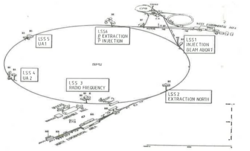|
UA4 experiment
  UA4 experiment (COULOMB[1]) was a high-energy physics experiment at the Proton-Antiproton Collider at CERN. The UA4 collaboration consisted of physicists from Amsterdam, Genova, Napoli, Pisa, Roma, California and CERN.[2] UA4 was approved on 18 January 1979, and the first phase of data taking lasted until 17 June 1985. The spokesperson of UA4 was Giorgi Matthiae.[1] UA4 was followed by UA4/2, a collaboration between Genova, Roma, Paris, Prague, Valencia and CERN.[3] The purpose of UA4/2 was to measure the ratio of real to the imaginary part of the forward elastic scattering amplitude.[3] It was approved in July 1990, and recorded data throughout 1991. The objective of the UA4 experiment was to measure the antiproton-proton cross-section, in order to show that cross-sections rising with energy are a characteristic of strong interaction.[2] One had previously measured proton-antiproton cross-sections at the Intersecting Storage Rings, but as the Proton-Antiproton Collider — a modification of the Super Proton Synchrotron — began operating, the measurements could be done in a new energy range: up to 540 GeV center-of-mass energy. Elastic events were detected by high resolution wire chambers and scintillation-counter hodoscopes. A system of drift chamber telescopes and counter telescopes were placed on the left and the right side of the crossing region to detect inelastic events.[4] After the period of data taking, the UA4 collaboration could conclude that proton-antiproton cross-section indeed rises with energy.[4] See alsoReferences
External links |
||||||||||||||||||
